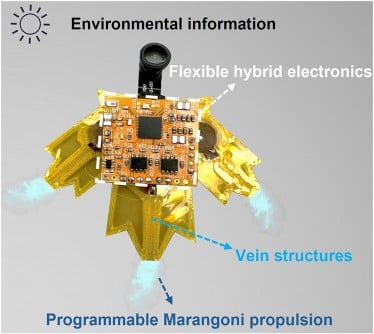UPDATE: Researchers from the University of Macau and Huazhong University of Science and Technology have unveiled groundbreaking S-aquabots that promise to transform aquatic robotics for environmental monitoring and search-and-rescue operations. These innovative robots utilize a Marangoni motor powered by ethanol, achieving remarkable fuel efficiency and precise maneuverability, with implications for ecological protection and scientific research.
The study, published online in eScience in May 2025, highlights the pressing need for untethered aquatic robots capable of adapting to various environments. Traditional designs often struggle with limited power and bulky components, but these new centimeter-scale robots demonstrate silent, energy-efficient movement while remaining nearly undetectable to wildlife.
The S-aquabots harness the Marangoni effect, inspired by nature, to propel themselves across water surfaces. By utilizing ethanol stored in chamber systems, these bots can navigate for up to 226 seconds on just 1.2 mL of fuel, covering distances of approximately 5 meters. This breakthrough improves fuel efficiency by an impressive 3.5 times compared to previous models.
Demonstrations of the S-aquabots included obstacle avoidance, pollutant collection, and real-time video transmission. Their design allows for dynamic movements, including U-turns and pre-programmed trajectories, enhancing their utility in various applications, from environmental monitoring to disaster response.
Prof. Junwen Zhong, the study’s corresponding author, emphasized the significance of this development:
“Our leaf-inspired S-aquabots demonstrate how biomimicry and advanced materials can overcome the long-standing challenges of aquatic robotics. The quiet motion and natural camouflage open possibilities for unobtrusive environmental monitoring.”
With their leaf-like shape, these robots can blend seamlessly into floating vegetation, making them ideal for tracking pollutants and monitoring water quality without disturbing ecosystems. Equipped with mini-cameras and sensors, the S-aquabots can gather vital data on air temperature and light intensity over extended periods.
Looking ahead, the integration of sustainable energy sources, such as solar cells, could further enhance the endurance of these versatile robots. Their capabilities represent a significant leap forward in the design of intelligent, adaptable, and eco-friendly aquatic systems.
In a world increasingly focused on environmental sustainability, the development of the S-aquabots signifies a vital step toward advancing technology that supports the preservation of aquatic environments. As researchers continue to refine these innovative devices, they hold the potential to revolutionize the field of environmental science and robotics, enabling more effective monitoring and response strategies in diverse aquatic settings.






